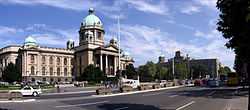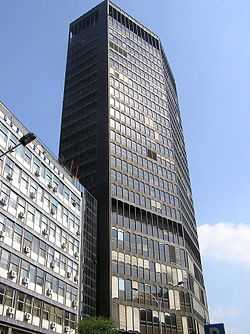Architecture of Belgrade

The Parliament of Serbia, and the headquarters of the
Serbian Post, erected in 1938

Temple of Saint Sava and monument of
KarađorđeArchitecture of Belgrade refers to the architecture and styles developed in Belgrade, Serbia.
Belgrade has wildly varying architecture, from the centre of Zemun, typical of a Central European town,[1] to the more modern architecture and spacious layout of New Belgrade. The oldest architecture is found in Kalemegdan park. Outside of Kalemegdan, the oldest buildings date only from 19th century, due to its geographic position and frequent wars and destructions.[2] The oldest public structure in Belgrade is a nondescript Turkish türbe, while the oldest house is a modest clay house on Dorćol, from late 18th century.[3] Western influence began in the 19th century, when the city completely transformed from an oriental town to the contemporary architecture of the time, with influences from neoclassicism, romanticism and academic art. Serbian architects took over the development from the foreign builders in the late 19th century, producing the National Theatre, Old Palace, Cathedral Church and later, in the early 20th century, the National Assembly and National Museum, influenced by art nouveau.[2] Elements of Neo-Byzantine architecture are present in buildings such as Vuk's Foundation, old Post Office in Kosovska street, and sacral architecture, such as St. Mark's Church (based on the Gračanica monastery), and the Temple of Saint Sava.[2]
During the period of Communist rule, much housing was built quickly and cheaply to house the huge influx of people from the countryside following World War II, sometimes resulting in the brutalist architecture of the blokovi (blocks) of New Belgrade; a socrealism trend briefly ruled, resulting in buildings like the Trade Union Hall.[2] However, in the mid-1950s, the modernist trends took over, and still dominate the Belgrade architecture.[2]
See also
References
|
|---|
| | Topics | |
|---|
| | Tallest buildings | |
|---|
| | Religious architecture | |
|---|
| | Historical buildings | |
|---|
| | Hotels | |
|---|
| | Business and transportation | |
|---|
| | Museums | |
|---|
| | Entertainment venues | |
|---|
| | Under construction | |
|---|
| | Proposed |
- Delta Planet Autokomanda
- Tennis Center Novak
- Delta City Blok 20
|
|---|
| | Architects and firms | |
|---|
|
Serbian architecture |
|---|
| | Styles | | |
|---|
| | Buildings and structures | |
|---|
| | Other | |
|---|
| Category |
|
Architecture of Europe |
|---|
| | By country | |
|---|
| | History | |
|---|
|



